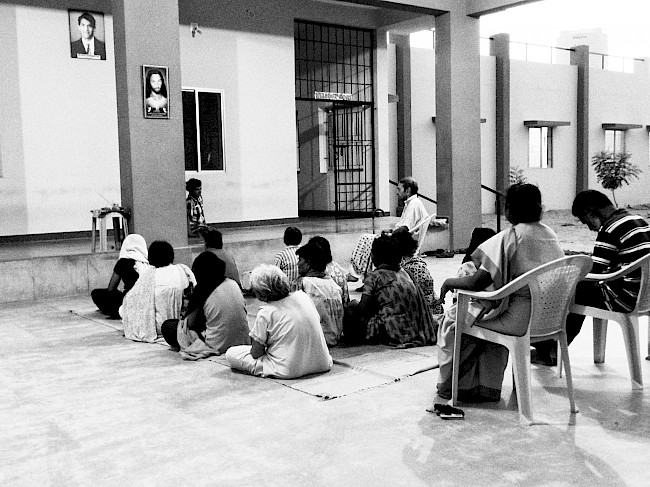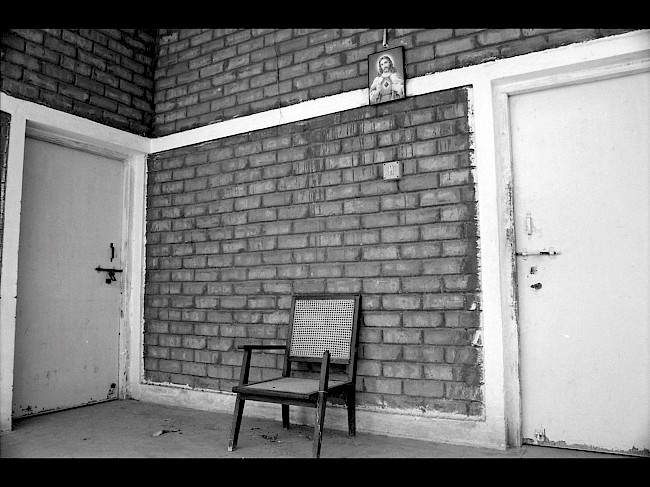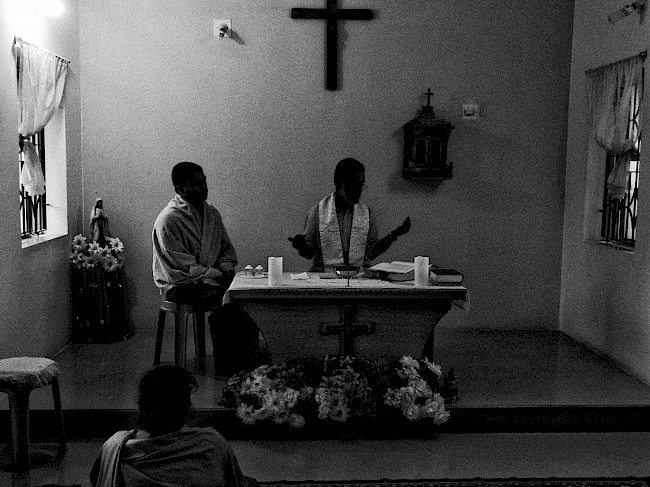The lives of terminally ill people with neuropsychiatric complications of AIDS
—
Description: In the background is the voice of one of the residents during an interview session. The first sound is that of my camera shutter.
Image 1: A resident looking at the camera while the Sister walks away from him.
Image 2: A wall clock inside the nurses’ building, above a jute poster of a house.
Image 3: Inside a locked room where the residents live. This used to be a playroom for children. This image reminded me of the play ‘A Doll’s House’ by Henrik Ibsen.
Image 4: The bed of one of the residents of the men’s ward. Even though male and female residents are allowed to mix freely, the wards where they sleep are separate.
Image 5: The entrance to the nurses’ building.
Eight hundred sixty-four square millimetres is the area of a 35-millimetre film surface within which an event or an emotion can be depicted. This is the area of a single frame in a roll of film used to make a photograph. A photograph is supposed to capture or freeze a moment and make it last forever. One can say that a photograph is one of the truths of the event it captures. I started this project to explore the contrast between different kinds of objectivity that surface while doing visual research on people with HIV and neurological disorders. The ‘events’ in this case are terminally ill people with neuropsychiatric complications arising out of HIV infection, living in an AIDS hospice in India. I use the camera as a tool not only to gather evidence of what I see but also to ask further questions. This audio-visual essay uses photographs and sound to explore the relationship between the residents’ subjectivities and their immediate physical environment.
Philip AIDS Centre is located in the Kutch district of Gujarat, India, about eighteen kilometres from the nearest railway station. From there it is a ride through the bustling markets until one enters the sparsely populated hinterlands, and from there one follows the dirt tracks. The centre houses terminally ill people living with AIDS who have been abandoned by their families. I visited the centre towards the end of April 2015 to document the lives of residents. Father Paul, who managed the centre, sounded very hospitable on the phone, and when we met he was much more than that. Compassionate and cynical, with a good sense of humour. This story starts from here, but their story goes a long way back.
I am formally trained as a research biologist. My PhD is in molecular cell biology of malaria; I tried to unravel how the human malaria parasite copes with biological stress, and its mechanisms of cell death. I discovered photography as a research tool during the long hours I spent with a microscope. This emboldened me to go out of my comfort zone and try to understand social aspects of malaria. The idea of how one experiences stress and death was a constant companion during these turbulent, exploratory times, and when I came to know of the Philip AIDS Centre I knew I had found my research interest. Very soon, I found myself trying to connect photography, ethnography, and cell biology, and to try to relate these to stress and death in disease conditions. I have now formally shifted my scientific research to HIV and neurological disorders, having taken a postdoctoral research position at the University of North Dakota. As always, I am still trying to connect these dots.
My interest in the topic begins from biological science. AIDS dementia complex (ADC), known earlier as HIV-associated dementia, is one of the most important, yet overlooked, neurological conditions in people living with AIDS. Neurocognitive disorders in HIV/AIDS patients typically present in the advanced stage of the disease. The virus (HIV-1), however, does not directly infect brain cells like neurons, astrocytes, and oligodendrocytes. HIV-1 infects macrophages and microglia, the brain’s immune cells (Watkins and Treisman 2015). This initiates a number of pathways that lead to neuronal cell death, thus contributing to neuropathogenesis in AIDS, including dementia. In general, incidence of ADC is observed in those with an all-time T-helper cell (CD4) count of below 200/mm3; there is some evidence linking CD4 count to severity of neuropsychiatric problems (Childs et al. 1999; Nakku et al. 2013). The patients at the centre over the past year had a mean CD4 count between 250 and 350 mm3.
So, who are these people?
Philip AIDS Centre is located near the junction of three seaports: Kandla, Adani, and Mandvi, places highly populated by long-distance truck drivers and a migrants coming from Gujarat, Maharashtra, and Karnataka to work in the shipping industry or at the port. Migrants and truck drivers have received a lot of public health attention in India; they are referred to as ‘bridge populations’ because they play a major role in transmitting HIV from high-risk groups (sex workers, drug users) to other populations (family members, children). All of the residents were abandoned by their families after they disclosed their HIV-positive status. It is not exactly clear at this point how each of the residents arrived at the centre, but most of them were referred by the Government Hospital for Mental Health, Bhuj. ‘The only qualification is that they have AIDS’, Father Paul told me.
The functioning of Philip AIDS Centre can be described as an ‘organizational pastiche’ (Kotarba and Hurt 1995, 435). Following the elements described by Kotarba and Hunt, the religious character of the hospice is one of the most audio-visually prominent elements. Even though the hospice is a Catholic establishment prominently displaying religious icons and symbols, the dual existence of Catholicism and Hinduism (among the residents) surfaces during the evening prayer session.
 Figure 1. Evening Prayer: Residents, Father Jose, and the nurse gather together for the evening prayer session. Everyone sings in a chorus, and some of the residents play musical instruments (cymbals and Indian drums).
Figure 1. Evening Prayer: Residents, Father Jose, and the nurse gather together for the evening prayer session. Everyone sings in a chorus, and some of the residents play musical instruments (cymbals and Indian drums). Figure 2. The porch outside the old kitchen, which also serves as a secondary reception area and a coffee station. It was inside one of these rooms that I would sit and chat with Father Paul over coffee.
Figure 2. The porch outside the old kitchen, which also serves as a secondary reception area and a coffee station. It was inside one of these rooms that I would sit and chat with Father Paul over coffee. Figure 3. The morning prayer session (at 05:00 every day) is held in a separate building where the Fathers have their lunch. In this image, Father Judy and Father Jose read the sermon, while a Sister sits and listens in the foreground.
Figure 3. The morning prayer session (at 05:00 every day) is held in a separate building where the Fathers have their lunch. In this image, Father Judy and Father Jose read the sermon, while a Sister sits and listens in the foreground. Figure 4. The room of one of the residents showing a small temple with images of Hindu gods and goddesses.
Figure 4. The room of one of the residents showing a small temple with images of Hindu gods and goddesses.What is the social shape of this zone, what are its boundaries, and who are the players? At Philip AIDS Centre, there is one trained nurse for the eighteen patients, among whom sixteen suffer from neuropsychiatric complications. She does a round of the wards from 07:30-08:00, and at 08:00 she administers daily medications to each of the patients and ensures that they swallow them. She does a second round in the afternoon at 16:00. There are prayers at 19:00 (each patient is free to pray to whomever they want), followed by another round led by one of the sisters after supper. While fresh vegetables and fruits are bought daily by Father Paul and Father Jose, the female patients themselves cook for all the patients. Cleaning is done by both male and female patients. Those who are not able to take care of themselves are assisted by other able-bodied patients. They laugh and joke with each other, chide one another, and nobody seems to be offended. There is a television set, and action films are as popular as wife/in-law drama serials. Really, sometimes I felt that there was nothing ‘mentally ill’ about these people, and that perhaps instead I was not quite right about their illness’s manifestations. Yet, the medical records of sixteen out of the eighteen patients revealed the diagnosis ‘psychosis, unspecified’. The chief psychiatrist at Government Hospital for Mental Health, Bhuj, puts the incidence of depression among AIDS patients as very high. Antidepressants, antipsychotics, and sleep medications are prescribed for all sixteen neuropsychiatric patients.
So, what is really ‘not normal’ here? Is it something with the brain, and inside their minds? Exploring the ‘relationship between the interiority of experience and its expressive exteriority’ (Irving 2011, 26) is what intrigues me the most and what poses an important challenge. About the nature of this challenge, Irving (2011, 25) writes that it:
presents a deep-seated difficulty for anthropologists, first, because it is primarily a methodological and practical problem rather than a conceptual one, and second, because conventional social scientific methods and measures are often too static to capture the unfinished, transitory, and ever-changing character of people’s interior experiences and expressions as they emerge in the present tense.
It is here that photographs and audio-visual evidence can be used both as clinical-anthropological evidence and to evoke emotions and raise awareness among caregivers and the public.
Description: Audio recording of a resident in the background.
Image 1: Residents sit on the veranda in the afternoon. This photograph was taken before the interview started.
Image 2: A maid goes into the residents’ kitchen. This photograph was taken after the interview concluded.
Image 3: One of the residents sits on his bed in the afternoon.
Visual representations of people with mental illnesses and their environment can be broadly grouped into three categories: photojournalistic, ethnographic, and film. Two contrasting photojournalistic depictions include Robin Hammond’s Condemned (http://www.robinhammond.co.uk/condemned-mental-health-in-african-countries-in-crisis/) and Mary Ellen Mark’s Ward 81 (http://www.maryellenmark.com/books/titles/ward_81/index001_ward81.html). Mark’s work resembles the daily life inside Philip AIDS Centre more closely and served as a primary inspiration for me. My photography for this work also derives inspiration from Josef Koudelka’s work on gypsies and theatre (https://pro.magnumphotos.com/Package/2TYRYD1KHF54). An important example of reporting on the complexity of human nature and experience in communicating with people with mental illnesses is Frederick Wiseman’s (1967) Titicut Follies.
I also draw upon cinematographic techniques used in direct/observational cinema,[note 1] such as using long shots and wide-angle lenses along with sound, and from the use of light and shadows as in German expressionist cinema. Along with visual representation, sound can also be used to enrich the film in both psychological and cultural contexts. Cinematic examples that emphasise the use of sound to depict a character’s mental state include the films of Roman Polanski (The Tenant and Repulsion) and Indian films such as Devi (Satyajit Ray), Hazaar Chaurasi Ki Maa (Govind Nihalani), Khandahar (Mrinal Sen), and Meghe Dhaka Tara (Ritwik Ghatak). These films use a mix of both ambient sound as well as instrumental music. In my audio recording of the evening prayer session at Philip AIDS Centre, the inclusion of sound adds another dimension of meaning. The raw audio recording of interviews can also be used to identify pauses and leaps, especially important in deciphering the narrative structure of a person with mental illness. Some or all of these techniques can be improvised/adapted and incorporated to build a compelling narrative that is true to the subject as well as to the character’s mental state. These challenges have been reviewed and discussed in Lemelson and Tucker 2015.
The aim behind my work is to understand the subjectivity of a terminally ill person living with AIDS, dementia, and psychosis, and to present this within a visual and auditory space that could perhaps inspire caregiving practices. Caring for a terminally ill person with AIDS and neurological disorders requires specialised training, which can be drawn from video recordings of caregiver–patient encounters. It can also be used to evoke empathy among people who choose to provide end-of-life care and care for their loved ones with mental illness at home. This point is true especially in a country like India where the zone of social abandonment can occur within the domestic space (Marrow and Luhrmann 2012). Narratives of residents at Philip AIDS Centre reveal a complex sequence of events following disclosure of their HIV status until the time they are picked up from the streets or the psychiatric hospital and admitted to the hospice. The common thread in all these narratives was that they lost their jobs once they told their HIV status to their families, friends, and employers, and were subsequently abandoned by their families. In this case, how and when their homelessness and social abandonment began requires further analysis. At the time this research was carried out, some families had reconciled to the residents’ terminal illness, while for residents’ families remain untraceable.
While I initiated this audio-visual work as a means to raise awareness about the multiple, intersecting issues mentioned in this essay, it slowly turned into a process of heightened awareness for me, allowing a deeper insight into the complexity and eccentricity of the human psyche. That is most fulfilling.
About the author
Gaurav Datta holds a PhD in molecular cell biology and his research was on understanding the mechanisms of cell stress and cell death in the human malaria parasite. His interest in anthropology is largely related to understanding how biochemical pathways give rise to disease and its manifestations in people, along with his long-standing interest in cinema. Within this, he is experimenting with techniques in audio-visual methods and arts-based approaches. This work was produced on a shoestring personal budget using black and white 35mm film. The text and all the images were approved for publication by Father Paul and the concerned patients. Datta is now exploring funding avenues to further this work.
References
Childs, E. A., R. H. Lyles, O. A. Selnes, B. Chen, E. N. Miller, B. A. Cohen, J. T. Becker, J. Mellors, and J. D. McArthur. 1999. ‘Plasma Viral Load and CD4 Lymphocytes Predict HIV-Associated Dementia and Sensory Neuropathy’. Neurology 52, no. 3: 607–13.
Ghatak, Ritwik. 1959. Meghe dhaka tara [The cloud-capped star]. 134 minutes. 35mm. Calcutta: Chitrakalpa.
Irving, Andrew. 2011. ‘Strange Distance: Towards an Anthropology of Interior Dialogue’. Medical Anthropology Quarterly 25, no. 1: 22–44. https://doi.org/10.1111/j.1548-1387.2010.01133.x.
Kotarba, Joseph A., and Darlene Hurt. 1995. ‘An Ethnography of an AIDS Hospice: Towards a Theory of Organizational Pastiche’. Symbolic Interaction 18, no. 4: 413–38.
Lemelson, Robert, and Annie Tucker. 2015. ‘Steps toward an Integration of Psychological and Visual Anthropology: Issues Raised in the Production of the Film Series Afflictions: Culture and Mental Illness in Indonesia’. Ethos 43, no. 1: 6–39. https://doi.org/10.1111/etho.12070.
Marrow, Jocelyn, and Tanya M. Luhrmann. 2012. ‘The Zone of Social Abandonment in Cultural Geography: On the Street in the United States, inside the Family in India.’ Culture, Medicine, & Psychiatry 36, no. 3: 493–513. https://doi.org/10.1007/s11013-012-9266-y.
Nakku, J., E. Kinyanda, and S. Hoskins. 2013. ‘Prevalence and Factors Associated with Probable HIV Dementia in an African Population: A Cross-Sectional Study of an HIV/AIDS Clinic Population. BMC Psychiatry 13: 126. https://doi.org/10.1186/1471-244X-13-126.
Nihalani, Govind. 1955. Hazaar Chaurasi ki maa [Mother of 1084]. 152 minutes. Udbhav Productions, Rudraa Entertainment Pvt. Ltd: Mumbai, India.
Polanski, Roman. 1976. Le locataire [The tenant]. 126 minutes. 35mm. Paris: Marianne Productions.
Polanski, Roman. 1965. Repulsion. 105 minutes. 35mm. United Kingdom: Compton Films, Royal Films International.
Ray, Satyajit. 1960. Devi [The goddess]. 93 minutes. 35mm. Calcutta: Satyajit Ray Productions.
Sen, Mrinal. 1983. Khandahar [The ruins]. 102 minutes. 35mm. Calcutta: Shree Bharat Laxmi Pictures.
Watkins, C. C., and G. J. Treisman. 2015. ‘Cognitive Impairment in Patients with AIDS: Prevalence and Severity’. HIV AIDS (Auckl) 7: 35–47. https://doi.org/10.2147/HIV.S39665.
Wiseman, Frederick. 1967. Titicut Follies. 84 minutes. 16mm/DVD. Cambridge, MA: Zipporah Films.
Endnotes
1 Back
A brief introduction can be found here: http://cinecollage.net/cinema-verite.html.